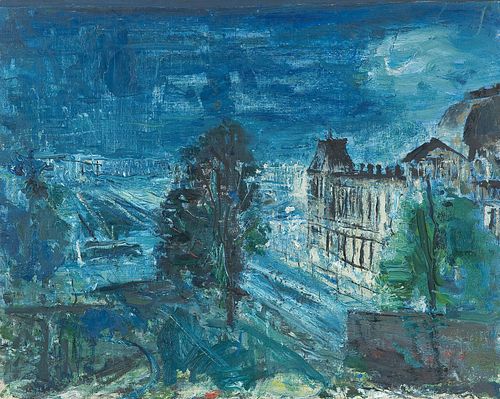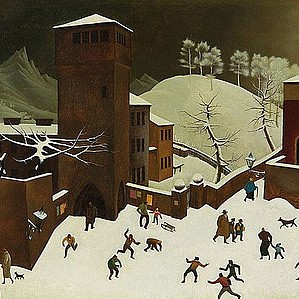WILHELM THÖNY (Graz 1888 - 1949 New York) Paris, hôtel de ville
Lot 91
Estimate:
EUR€25,000 - EUR€45,000
$26,881.72 - $48,387.10
Absentee vs Live bid
Two ways to bid:
- Leave a max absentee bid and the platform will bid on your behalf up to your maximum bid during the live auction.
- Bid live during the auction and your bids will be submitted real-time to the auctioneer.
Bid Increments
| Price | Bid Increment |
|---|---|
| EUR€0 | EUR€10 |
| EUR€100 | EUR€50 |
| EUR€700 | EUR€100 |
| EUR€1,000 | EUR€200 |
| EUR€3,000 | EUR€300 |
| EUR€3,600 | EUR€400 |
| EUR€4,000 | EUR€500 |
| EUR€7,000 | EUR€1,000 |
| EUR€16,000 | EUR€2,000 |
| EUR€30,000 | EUR€3,000 |
| EUR€36,000 | EUR€4,000 |
| EUR€40,000 | EUR€5,000 |
About Auction
By Widder Auctions
May 19, 2022
Set Reminder
2022-05-19 11:00:00
2022-05-19 11:00:00
America/New_York
Bidsquare
Bidsquare : Masterpieces
https://www.bidsquare.com/auctions/widder-auctions/masterpieces-9287
Masterpieces of classical modernism by Austrian and international artists coming up for auction in Vienna on May 19th Widder Auctions office@widderauktionen.com
Masterpieces of classical modernism by Austrian and international artists coming up for auction in Vienna on May 19th Widder Auctions office@widderauktionen.com
- Lot Description
WILHELM THÖNY
(Graz 1888 - 1949 New York)
Paris, hôtel de ville
oil/canvas/cardboard, 35,3 x 44,5 cm
signed W. Thöny
Provenance: Fine Arts Kohlhammer and Mahringer, auction house at Kinsky, private property
ESTIMATE € 25.000 - 45.000
Austrian painter, graphic artist, etcher and illustrator of the 20th century, important representative of Austrian modernism. 1908 to 1912 studied at the Academy of Fine Arts with Angelo Jank and Gabriel von Hackl. Also training in singing and playing the piano. Co-founder of the Munich Secession, lifelong acquaintance with Alfred Kubin. As a one-year volunteer in World War I, he created portrait studies and illustrations as a regimental painter. 1923 co-founder of the Graz Secession. 1925 Marries Thea Herrmann-Trautner, daughter of the American painter Frank S. Herrmann, sister of the painter and caricaturist Eva Herrmann. 1929 first stay in Paris, lived in Paris from 1931 to 1938. 1938 Emigrated to New York with his Jewish wife. 1948 Destruction of most of his works in a fire in a warehouse in New York. Diverse themes and techniques, landscapes and above all cityscapes of large cities such as Paris and New York. The genre scenes also show engagement with Advard Munch and August Macke.
At the end of the 1920s, Thöny experienced a period of upheaval, both in terms of his private life and his professional career. After the failure of his marriage to the American Fanny Hilma Walbourg White, he met another American in 1925: the daughter of the painter Frank Herrmann, Thea Trautner, who would later become his second wife. In 1927, Thöny worked for the Munich magazine "Die Jugend" and the Berlin magazine "Cross Section". After receiving the title of professor from the Austrian Federal President in July 1929, he and his wife traveled to Paris for a few weeks in September. A year later he was honored by the Austrian federal government with an honorary state award and at the same time became a full member of the Vienna, Prague and New Munich Secessions. In 1931, Thöny decided to move to Paris with his American wife Thea Herrmann-Trautner. In his cityscapes of the French metropolis, which he created as drawings, watercolors or oil paintings, his artistic sense for the atmospheric is sharpened and his delving into the hallucinatory and visionary is part of his unmistakable pictorial language. In Thöny's Paris cityscape, bathed in nocturnal blue, we see the Paris City Hall from an elevated position on the other bank of the Seine, probably from a window of a building on the Quais de Bourbon or the Place Louis Aragon. The painting shows references to abstract expressionism due to its web of coarse, erratic strokes and dabs of paint, from which rhythms and structures are formed. But Thöny was also fascinated by the observation of the most diverse social classes and everyday events. He kept in touch with his circle of friends at home: Thöny liked to correspond and corresponded a lot because he wanted to share his experiences with the friends he had left behind in Graz, especially during those years in Paris. To this end he often provided these letters with delightful marginal drawings for better illustration. Sometimes, with the same intention, he enclosed drawings the size of a letterhead with his letters, which is still remembered today by the creases in the paper of these drawings. In 1938, Thöny felt so unsettled by the political developments that he and his second wife, American Thea Trautner, moved to New York in March 1938.
PLEASE NOTE:
The purchase price consists of the highest bid plus the buyer's premium, sales tax and, if applicable, the fee of artists resale rights. In the case of normal taxation (marked ° in the catalog), a premium of 24% is added to the highest bid. The mandatory sales tax of 13% is added to the sum of the highest bid and the buyer's premium. The buyer's premium amounts to 28% in case of differential taxation. The sales tax is included in the differential taxation. - Shipping Info
-
Shipping
We will send you the invoice shortly after the auction. As soon as we have recieved the amount, the art can be picked up at Johannesgasse 9-13, 1010 Vienna. Please note that the buyer is responsible for pick-up and shipping of the lot.
Should you wish to ship your items, please contact: Mailboxes Email: oper@mbe-co.at Tel: 01 5128855
Please note that storage fees may apply, should the pieces not be picked up within 14 days after invoicing for domestic and 28 days for international transportation.
Our team will be happy to assist you with any further information at office@widderauktionen.com or at 0043 676 555 66 10.
-
- Buyer's Premium



 EUR
EUR CAD
CAD AUD
AUD GBP
GBP MXN
MXN HKD
HKD CNY
CNY MYR
MYR SEK
SEK SGD
SGD CHF
CHF THB
THB













